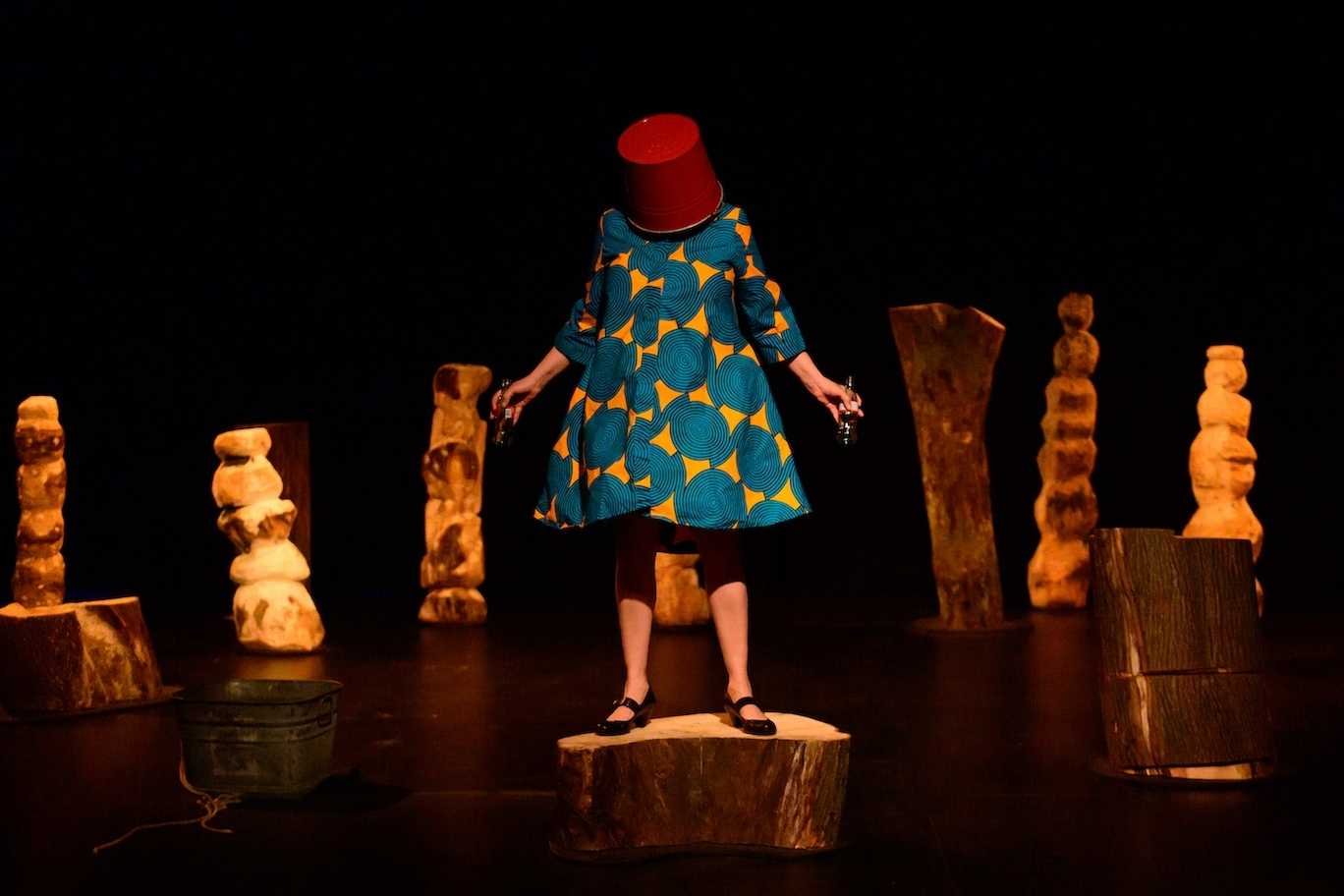Land Of The Living
The Rhubarb Festival 2022. Buddies in Bad Time Theatre
Invited by Festival Director Clayton Lee
Installation by Andrea Shin Ling
Photo Credit: Henry Chan
Andrea Shin Ling’s large-scale installation, Calculus of an infinite rot, part.1, provided the setting to all of the works presented at the 2022 Rhubarb Festival. The installation consisted of 34 tree stumps that had been inoculated with bacteria to encourage the production of mold and fungi. Leaning into the urgency of the global pandemic, festival Director Clayton Lee’s invitation to all festival performers was to offer their own response to Ling’s installation. Louise Liliefeldt, an acclaimed and influential staple of Toronto’s performance art scene for over 30 years, presented a new work in this context entitled Land of The Living. Influenced by her family’s history living in South Africa during apartheid, Liliefeldt’s body of performance work forefronts an unwavering commitment to making visible and honoring peoples’ resilience against the horrors of race, gender, and class-based violence. In all of her endurance-based and durational performative works, Liliefeldt directly or indirectly aligns herself with historically oppressed identities with a dignified pride. Liliefeldt’s ability to represent the pain and struggle of identity without calling out to the viewer’s sympathy is unique. Instead, Liliefeldt displays her physical and psychological strength in ways that are at times almost overwhelming to witness.
At the beginning of Land of The Living, we enter the dimly-lit space and find Louise on the ground, crouched in a fetal-like position. Her body wraps awkwardly around one of Ling’s tree stumps. She is wearing black pants and her black shirt is pulled off her back and over her head, covering her face. Her body is still in this position as she deeply inhales and exhales, letting the natural but forceful sound of rhythmic breathing fill the space. After some time, Louise moves on to other areas of the space, each time migrating her body from one tree stump to another in strange and unfamiliar ways, employing a combat crawl, walking backwards, or bear crawling across the floor on her open palms and bare feet. Both her movements and tableaus seemed to respond to Ling’s work by referencing the inconspicuous activities of flora and fauna. After physically responding to the tree stumps in their organic and true form, in the next two sections of the performance, Liliefeldt renders Ling’s work as utilitarian and functional objects, namely a seat and a stage.
Initiating the second set of actions, Louise moves to the corner of the room and returns pulling behind her a rope attached to a wide-rimmed metal bucket. This bucket, a recurring object in many of Liliefeldt’s performances, evokes images of the laborious transportation of goods. Louise pulls the metal bucket and its contents to a tree stump raised just inches from the ground. She turns away from the audience and crouches down to sit on it, straddling the bucket with her legs. Louise places her hands in the bucket and, by moving them from side to side, causes water to spill over the rim and the glass bottles inside to clink against one another and the metal. From the water, she pulls out the familiar and classic silhouette of a Coca-Cola bottle. She opens it, but doesn’t drink. Instead, she tilts her head back and places the base of the bottle in her mouth, holding it here. Slowly leaning forward until the Coca-Cola starts to spill out from the bottle and into the bucket she washes her hands in the soda with an impartial regularity as if the liquid was water. After repeating the same action with a second bottle, Louise stands up and moves around the space using the repurposed bottles as cheap instruments, playing them in irregular intervals while weaving between the tree stumps in a staggered shuffle. The Coca-Cola bottles gesture to street vendors, the global south, informal economies, and sugar’s historical connection to colonialism and slavery.
About an hour into the piece, Louise move towards the black curtain at the back of the space and steps behind it. The final segment of the performance commences when she reappears, now wearing a knee-length dress made from identifiably blue and yellow African wax fabric, black heels, and a small red plastic bucket that fits perfectly over her head concealing her face. Using what little vision she has to guide her, she carefully walks towards a low wide tree stump in the center of the space. She steps on the stump, strikes and then holds a quintessentially enigmatic and iconographic Liliefeldt pose.
Unlike the functional metal bucket, the red bucket covering her face is devoid of function. It is useless and disturbingly absurd. This feeling becomes exaggerated when Louise begins to shuffle her feet, tapping on the stump while jerking her hands in a dance that is both playful and strange. This action evoked several historical references of Black tap dancers, particularly ones performing for predominately White audiences. Louise intentionally places herself in a degrading and almost humiliating position, precariously balanced on an unstable tree stump, tapping for people she cannot see. Yet, Louise stands confidently as she dances, sometimes making sounds from under the bucket that are hard to interpret.
In Land of the Living, Liliefeldt displays an unmatched ability to subvert the assumed power relations between audience and subject. Despite putting herself in vulnerable positions that reference racist imagery and histories of exploitation, she exudes an undeniable command over the audience. Her hypnotizing and intense presence exudes a power over any projection the viewer might attempt to force upon her.
~ Nahed Mansour 2022





